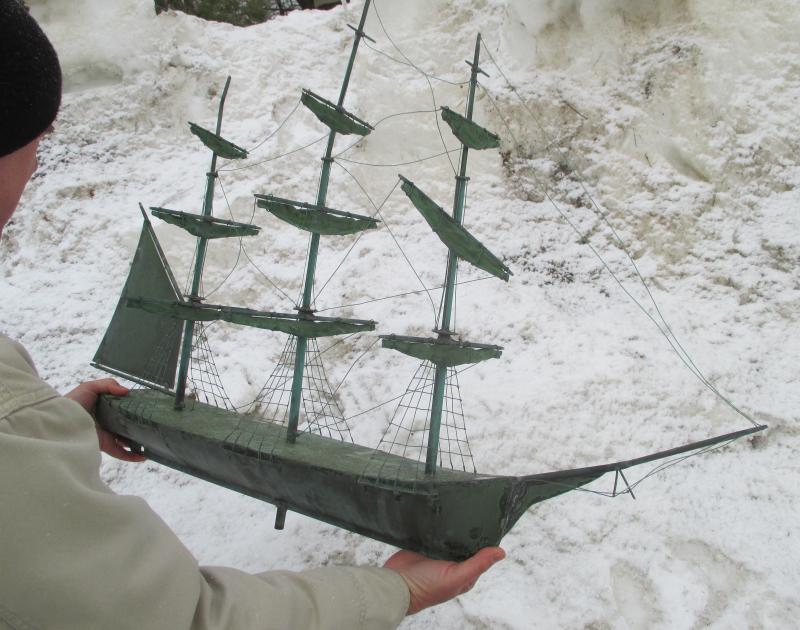Wiscasset weather vane awaits town’s direction
 The weather vane of the whaling schooner Wiscasset as it looks today. The hand-forged replica was made entirely of copper by the late Gil Whitman in 1968 and was a gift to the town of Wiscasset from an Edgecomb couple. Courtesy of Phil Di Vece
The weather vane of the whaling schooner Wiscasset as it looks today. The hand-forged replica was made entirely of copper by the late Gil Whitman in 1968 and was a gift to the town of Wiscasset from an Edgecomb couple. Courtesy of Phil Di Vece
 The weather vane of the whaling schooner Wiscasset as it looks today. The hand-forged replica was made entirely of copper by the late Gil Whitman in 1968 and was a gift to the town of Wiscasset from an Edgecomb couple. Courtesy of Phil Di Vece
The weather vane of the whaling schooner Wiscasset as it looks today. The hand-forged replica was made entirely of copper by the late Gil Whitman in 1968 and was a gift to the town of Wiscasset from an Edgecomb couple. Courtesy of Phil Di Vece
Seeing Wiscasset’s municipal building minus its cupola takes a little getting used to.
Residents will recall it was removed after the roof was replaced and won’t be coming back, the powers that be having decided it was too expensive to maintain. But what happened to the weather vane of a sailing ship on top of the cupola, where did it disappear to?
For now it’s locked in a garage until selectmen decide what to do with it.
The ship weather vane has a unique history; although not nearly so renowned as the one pointing the wind direction on the steeple of Wiscasset’s Congregational Church; that one came from the foundry of Paul Revere. Nevertheless, the ship weather vane is one of a kind having been hand-forged by a local artisan nearly 50 years ago.
"It was the handiwork of the late Gil Whitman of Edgecomb,” Larry Gordon of Federal Street said. “As I recall, when the municipal building was nearing completion he was commissioned privately to make a weather vane for the top of the cupola. They asked him to make a replica of the schooner ship Wiscasset.”
Gordon, a longtime Wiscasset selectman, couldn’t recall who it was that commissioned the work.
“I honestly don’t recall, but I know the townspeople were very pleased with Mr. Whitman’s work when he presented it to the town.”
Gordon said the weather vane was unveiled when the town dedicated its new municipal building. The ceremony took place on the afternoon of May 26, 1968.
“If I remember correctly, after the dedication, the town hired the late Oscar Hanley to attach the weather vane on the top of the cupola,” he added, which is where it stayed until the cupola was taken down.
For the record, the original donors were the late Neal Creamer and his wife Betty of Edgecomb. Neal was a past trustee of the Wiscasset Public Library. Betty, now 92, divides her time between Edgecomb during the summer and Lexington, Kentucky during the winter.
The Creamers commissioned Gilman to make a replica of the Wiscasset; a whaling schooner that plied the Pacific waters hunting whales in the 1830s. Whales were harvested chiefly for oil that was rendered from their blubber.
The weather vane is made entirely of copper and stands about four feet tall and two feet wide.
“It’s really in very good condition considering its age,” Steve Christiansen, a town employee said. “It needs a few minor repairs; some of the wires that serve as the ship’s rigging have comes loose and need to be soldered, but otherwise it’s in fine shape. Over the years it’s developed a green patina on its surface from being exposed to the elements. As far as I know, it always worked beautifully as far as telling which direction the wind was blowing from.”
Christiansen enjoys researching and sharing facts concerning Wiscasset’s past. Among the memorabilia he collected is a newspaper article announcing the Wiscasset Municipal Building’s dedication. The paper names Whitman as the weather vane’s maker.
“I was told, or read someplace, that Gil Whitman made his replica of the ship from a picture of it carved on a whale tooth,” he added.
This unusual fact was confirmed in two other newspaper articles from the 1960s that were found in the Wiscasset Public Library’s archives. As reported by the Portland Press Herald and the Boothbay Register, a likeness of the whale ship Wiscasset was discovered on a piece of scrimshaw. Carefully carved in a whale tooth is a picture of the three-masted schooner under full sail during a whale hunt. The historic carving is now on display in the Nickels-Sortwell House museum on Main Street, Wiscasset.
The Wiscasset was the only whaling vessel to ever have shipped from the Port of Wiscasset. The ship’s history is told in some detail within Fanny S. Chase’s “History of Wiscasset in Pownalborough.”
The weather vane artisan
Gil Whitman, given name Gilman Bertrand Whitman, died just recently on March 17, 2015 at the Veteran’s Home in South Paris. He was 88.
Whitman is well-remembered for having owned and operated The Yankee Craftsman and Lincoln Forge alongside his home in North Edgecomb. He and his wife Elizabeth lived in a rambling Colonial farmhouse next door to the Pioneer Motel on Route 1.
In the 1970s and 80s, he worked in his forge fashioning bronze statues, wrought iron banisters, chandeliers and ornamental pieces including one of Donald B. MacMillian’s famous arctic schooner Bowdoin. Having become nationally renowned as a metal artisan, he later changed the name of his studio and forge to Gil Whitman’s Gallery.
In 1998, Whitman moved to Bryant Pond (Woodstock) where one of his final sculptures can be seen near the town’s post office, the towering Candlestick telephone.
The newspaper articles reveal that it took Whitman two weeks to make his Wiscasset replica, which he fashioned exactly to scale, measuring one-quarter inch to the foot. He also made the weather vane’s pivoting rod and directional points.
Although many sailing ships were built in Wiscasset during the 18th and 19th centuries, the Wiscasset was constructed along the shores of the Damariscotta River in the town of Nobleboro.
Wiscasset was launched in October of 1833 and shortly thereafter purchased by the Wiscasset Whale Fishing Company, the new owners christening her the Wiscasset. Creamer’s great-grandfather, Barker Neal, was one of the whaling company’s 19 shareholders. The Wiscasset set sail on its first voyage the following spring bound for the Pacific. The ship returned 120 days later fully laden with over 2,800 barrels of whale oil.
It was during this maiden voyage that a crewman carved a picture of the schooner in a whale tooth. The picture was said to commemorate the taking of a bull sperm whale of a colossal size. It was from a photograph of this picture that Gilman designed and forged his copper model.
In the early 1840s the Wiscasset was sold to a whaling firm in Sag Harbor, Long Island. After the demand for whale oil plummeted, the ship was sold again to Taylor & Merrill of Manhattan whose owners refitted the 380-ton vessel to use as a transatlantic passenger ship.
One of the ship’s passengers was the future industrialist Andrew Carnegie, who shipped aboard it as a lad of 12 in the spring of 1848. Later in life, Carnegie shared fond memories of the voyage he made from Glasgow, Scotland to New York City with his parents and infant brother. The Atlantic crossing took 42 days.
Sadly, the fate of the Wiscasset ended in tragedy: Sometime in 1850, it was lost at sea wrecked on one of the Sandwich Islands in the Pacific.
As for the weather vane, for the present, its fate has yet to be determined and rests with the board of selectmen. Chairman Pam Dunning is certain a new place can be found for it.
“As most people know, the cupola on the town office was removed because of its leaking and having caused so much water damage inside the building over the years,” she said.
Selectmen haven’t talked about what to do with the weather vane. For the present, it’s safely stored under lock and key.
Event Date
Address
United States





















